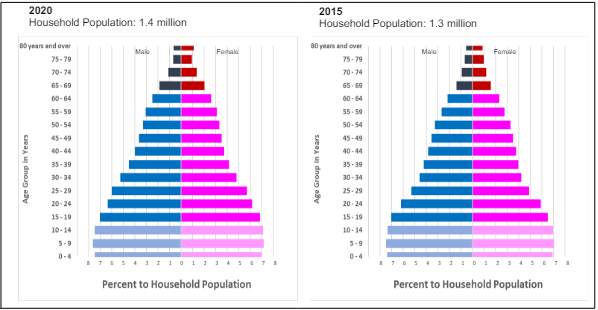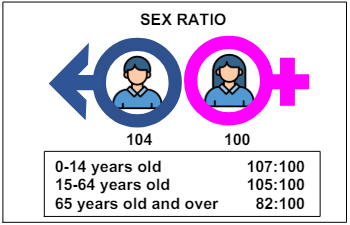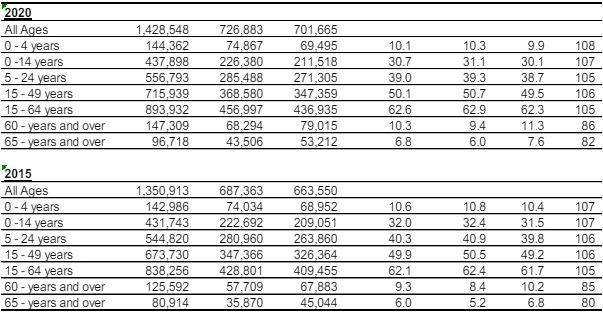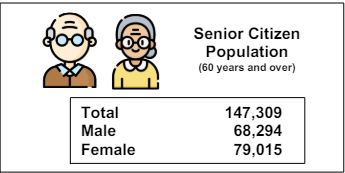Age and Sex Distribution in Negros Oriental Population
(2020 Census of Population and Housing)
Household population comprised 99.7 percent
Based on the 2020 Census of Population and Housing (2020 CPH), Negros Oriental had a total population of 1,432,990 persons. Of this total, the household population comprised 99.7 percent or 1,428,548 persons.
Of the 1.4 million household population in 2020, 726 thousand (50.9%) were males while 701 thousand (49.1%) were females. By age group, 437 thousand (30.7%) were under 15 years of age (young dependents). On the other hand, persons aged 15 to 64 years (working-age or economically-active population) totaled to 893 thousand (62.6%) while those in age groups 65 years and over (old dependents) comprised the remaining 96 thousand (6.8%). In 2015, persons aged 0 to 14 years, 15 to 64 years, and 65 years and over accounted for 32.0, 62.1, and 6.0 percent, respectively, of the household population.
Figure 1. Age-Sex Pyramid of Negros Oriental: 2020 and 2015

Sources: Philippine Statistics Authority, 2020 Census of Population and Housing and 2015 Census of Population
Moreover, there were more males (51.6%) than females (48.4%) among the 0 to 49 age group. Meanwhile, among the older age group (50 years and over), females (52.0%) outnumbered the males (48.0%). (Figure 1)
Sex Ratio stands at 104 males per 100 females
The sex ratio in Negros Oriental was computed at 104 in 2020. This means that there were 104 males for every 100 females. In 2020, children aged below 15 years had a sex ratio of 107 males per 100 females, while those aged 15 to 64 years had a sex ratio of 105 males per 100 females. Moreover, among those aged 65 years and over, the sex ratio was 82 males per 100 females. This depicts a longer life expectancy among females than males or a higher mortality rate among males than females in the older age groups. (Figure 2)
Figure 2. Sex Ratio by Selected Age Group: Negros Oriental, 2020

Source: Philippine Statistics Authority, 2020 Census of Population and Housing
Dependency ratio is 60 dependents per 100 persons in the working-age group
The dependency ratio of Negros Oriental was computed at 60, which indicates that every 100 working-age or economically-active population, there were about 60 dependents (49 young dependents and 11 old dependents). This is lower than the dependency ratio in 2015, which was recorded at 61 dependents per 100 working-age population (51 young dependents and 10 old dependents). (Table 1)
Table 1. Age Dependency Ratio of the Household Population by Sex: Negros Oriental, 2020, 2015

Sources: Philippine Statistics Authority, 2020 Census of Population and Housing and 2015 Census of Population
Note: Details may not add up to the total due to rounding.
More males than females in children under five years old
Children below five years old comprised 10.1 percent (144 thousand) of the household population which is slightly lower than the 10.6 percent (142 thousand) posted in 2015. The sex ratio increased at 108 males per 100 females in 2020 from the 107 males per 100 females in 2015. (Table 2)
Table 2. Number and Percent to All Ages of Household Population and Sex Ratio by Age Group: Negros Oriental, 2020 and 2015

Sources: Philippine Statistics Authority, 2020 Census of Population and Housing and 2015 Census of Population
About two in every five household population are of school age
In 2020, the school-age population (5 to 24 years old) accounted for 556 thousand (39.0%) of the 1.4 million household population compared to the 544 thousand (40.3%) school-age population that was reported in 2015. (Table 2)
Almost half of the female population are of reproductive age
Women of reproductive age (15-49 years old) totaled to 347 thousand or 49.5 percent of the 701 thousand female household population in 2020. These figures were higher compared with the 49.2 percent (326) thousand posted in 2015. (Table 2)
Senior Citizens constitute 10.3 percent of the household population
In Negros Oriental, people aged 60 years old and over are regarded as senior citizens. They made up 10.3 percent (147 thousand) of the household population in 2020, higher than the 9.3 percent (125 thousand) recorded in 2015. There were more females (53.6%) than males (46.4%) among the senior citizens, in 2020. The same trend was observed in 2015. (Table 2 and Figure 3)
Figure 3. Senior Citizen by Sex: Negros Oriental, 2020

Source: Philippine Statistics Authority, 2020 Census of Population and Housing
SGD
ARIEL T. FORTUITO
Chief Statistical Specialist

